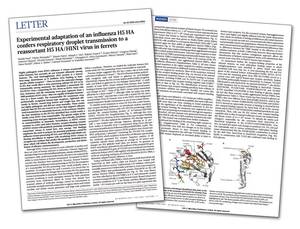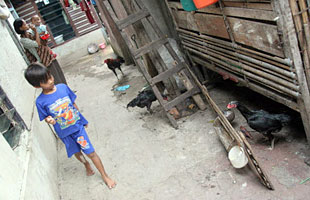H5N1, the movie
2012/04/21 Carton Virto, Eider - Elhuyar Zientzia
29 of March. Washington. American Institute of Health. Silence in the meeting room with weapons. Attendees have two hours to read articles and make observations. They have accepted and signed the confidentiality document before receiving the articles. At the end of the reading the papers and notes have been delivered. They have been destroyed. They cannot fall into the hands of criminals.
It could be a scene from a film about spies and plotters, but not. Indeed, last March 29, or so has been recorded in the chronicle of the journal Science. With this silent session, the reevaluation of the results of two studies with the H5N1 influenza virus began. “The two most famous scientific articles that have never been published,” said one of the participants.
The Science chronicle tells the succession to the silent reading of scientific presentations and debates, as well as the “displacements to confidential questionnaire sessions”. No component of spy movies was missing. With former FBI agent.
The Biosecurity Advisory Council of the United States favored the publication of the two articles in its entirety after voting at the end of the day and was informed the following day: in view of the additional information presented by the researchers, the request was dismissed three months earlier. One of the articles, owned by researcher Yoshihiro Kawaoka of the University Wisconsin-Madison of the United States, was unanimously supported; the other, by researcher Ron Foulchier of the medical research center Erasmus of Rotterdam, received six votes against since 18. Thus, both articles will be published in the journals Science and Nature as planned, and all researchers will have access to data, not limiting access to authorized individuals.
The new recommendation of the Biosafety Advisory Council has been added to what was agreed at the end of last February at the meeting of the World Health Organization, which states that the full publication of the investigations will contribute more than to a detriment to public health. In fact, in these investigations, both groups have created variants of H5N1 avian influenza mutationally in the laboratory and have seen that the new variants have been able to spread ferrets through the airways. Ferrets are the best example for conducting studies of human influenza that is spread through the airways, so the results are worrying: variations have acquired capacity through very few mutations and indicate that the H5N1 virus of birds can produce a pandemic of influenza in humans greater than expected. Therefore, it is important that all members of the influenza surveillance network know these mutations and variants so that they can be attentive in case they arise naturally.
In recent months, however, the findings of the investigations have raised more concern and turmoil than the very conclusions about the publication of the results and censorship, and this March meeting, which seems closer to fiction than reality, has been the guing of the pie. Ging a bitter cake for my taste. Because I love the terrible world of the bioterrorism ghost that reflects H5N1, for the semi-happy ending of the film. One thing is that double-use investigations follow strict safety standards and measures; another is paranoia.
Published in the newspaper Berria.
Gai honi buruzko eduki gehiago
Elhuyarrek garatutako teknologia





